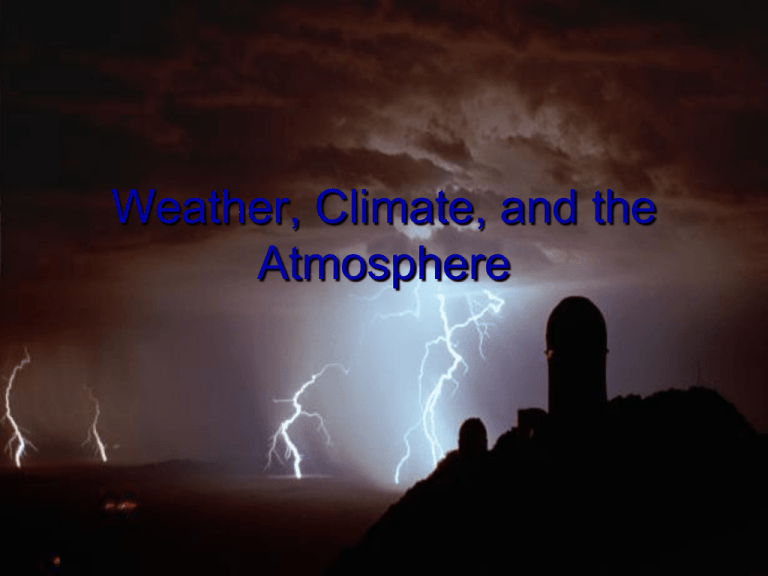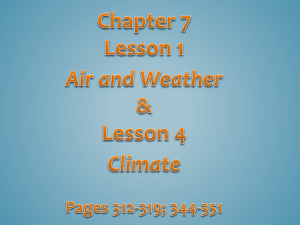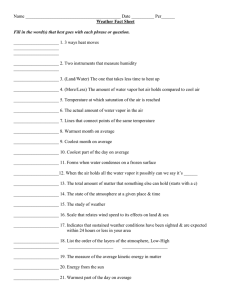Weather Powerpoint
advertisement

Weather, Climate, and the Atmosphere Composition of the Atmosphere What is weather? Weather is the condition of the Earth’s atmosphere at a particular time and place. – Example: What is the weather outside right now? – Not an Example – What is North Carolina weather in the fall? What is Climate ? Climate is the general patterns of weather a place experiences over time. What Determines Climate Temperature Precipitation Factors That Affect Temperature Latitude: distance north and south of equator Areas close to the equator (0˚ latitude), receive the direct rays of the sun. I57 What type of climate do these areas have? Where do the lowest average temperatures occur? Near the Poles ( 90˚ north or south) Elevation (Altitude) What becomes less dense as elevation increases? Less-dense air cannot hold as much heat as denser air. What does this cause the temperature to do? (It decreases) Ocean Currents An ocean current is a “river” of water that flows in a definite path in the ocean. I115 They are either warm or cold currents. The surface temperature of water affects the temperature of _____________? Air above it Ocean Currents Currents traveling away from the equator are warm water currents. Currents traveling toward the equator are cold water currents. Factors That Affect Precipitation Prevailing Winds : A wind that blows more often from one direction than from any other direction. Prevailing Winds Warm: holds more moisture Warm air rises and then cools so it cannot hold the moisture; therefore, it falls to earth as some type of precipitation. Cold: holds less moisture Cold air sinks and becomes warmer so it can hold more moisture. Due to this there will be little precipitation. Prevailing Winds Direction from which they blow determines how much moisture it carries 1. Land to water (land breeze) 2. Water to Land (sea breeze) Which kind of wind carries more moisture? Prevailing Winds How can the Sahara desert exist near the Atlantic Ocean and only receive less than 25 centimeters of rainfall? I116 Land and Sea Breezes Why does land heat up and cool down faster than water? Soil and vegetation reflect less solar radiation than water. The solar radiation heats up the very top of the land surface. It cannot penetrate the soil at a deep level. Vegetation absorbs solar radiation and stores it for energy. Land and Sea Breezes Water will reflect most of the solar radiation back into the atmosphere. The remainder can penetrate into the water Monsoons What is a monsoon? The name "monsoon" is derived from the Arabic word “mausim" which means "season" or "wind-shift". Monsoons Sea and Land breezes over a large region that changes direction with the seasons are called monsoons. Page 56I What is the Atmosphere? Remember! Atmos – Vapor Sphere – Ball The Atmosphere is a layer of gasses that surround Earth or any planet. Why is the atmosphere important: 1. We need the gases for survival. 2. It prevents the earth from being hit by meteoroids 3. Heats the water on earth to keep most of it in liquid form 4. Protects us from the What is in our atmosphere? Gases (dry air) 1. Nitrogen 78% - N2 2. Oxygen 21% - O2 What else is in the atmosphere? 3. Carbon Dioxide less than 1% - CO2 4. Trace Gases – less than 1% of argon, helium, methane, krypton, & hydrogen What else is in the atmosphere? Water Vapor – Water in the form of a gas The amount of water vapor varies from 0 – 5%. Example – Desert – O% Example – Rainforest – 5 % What else is in the atmosphere? Particles Examples: – Dust – Smoke – Salt – Other Chemicals Is it OK to be dirty? YES!! (to a certain degree) When water vapor condenses to form clouds it must have something to stick to in the atmosphere. Natural pollutants are just the thing that clouds need. Pollution What is Pollution? Harmful substances in the air, water or soil. Is some pollution OK? YES!! Salt Spray Mold Pollen Erosion Forest Fires Dust Storm Animal Dander Volcanic Eruption These are all Natural Pollutants. BUT SOME IS NOT!! Un- natural Pollution = Human Activities ½ - motor vehicles ¼ - factories and power plant ¼ - farming, construction, burning fossil fuels (wood and coal) Smog = Smoke + Fog London Smog – coal particles + Water Vapor in the humid air in England Photochemical Smog sunlight + chemicals in the air released by motor vehicles and factories Acid Rain Chemicals called oxides mix with water in the air to make the rain acidic (Draw this) Precipitation carries acid from the air to trees, water sources, and buildings NOW WHAT? Pollution Restrictions by US Government Higher standards for clean cars More affordable and reliable Hybrid/electric vehicles








